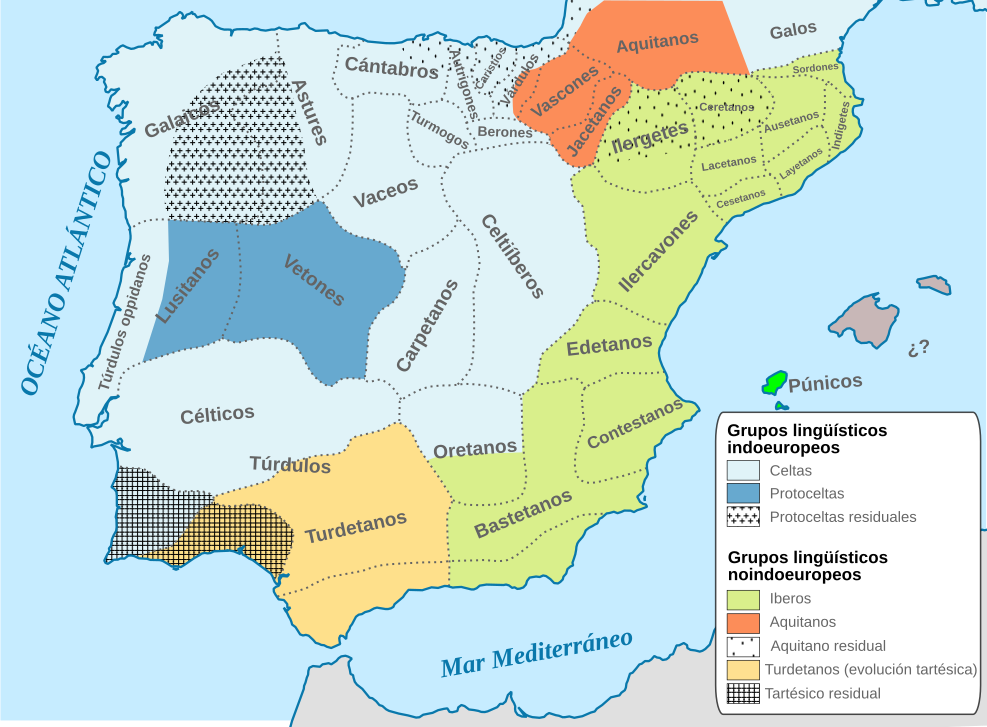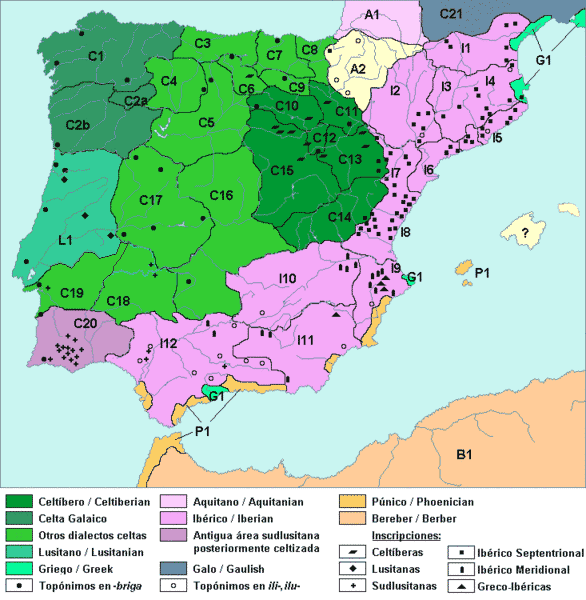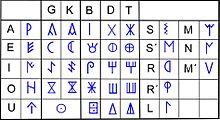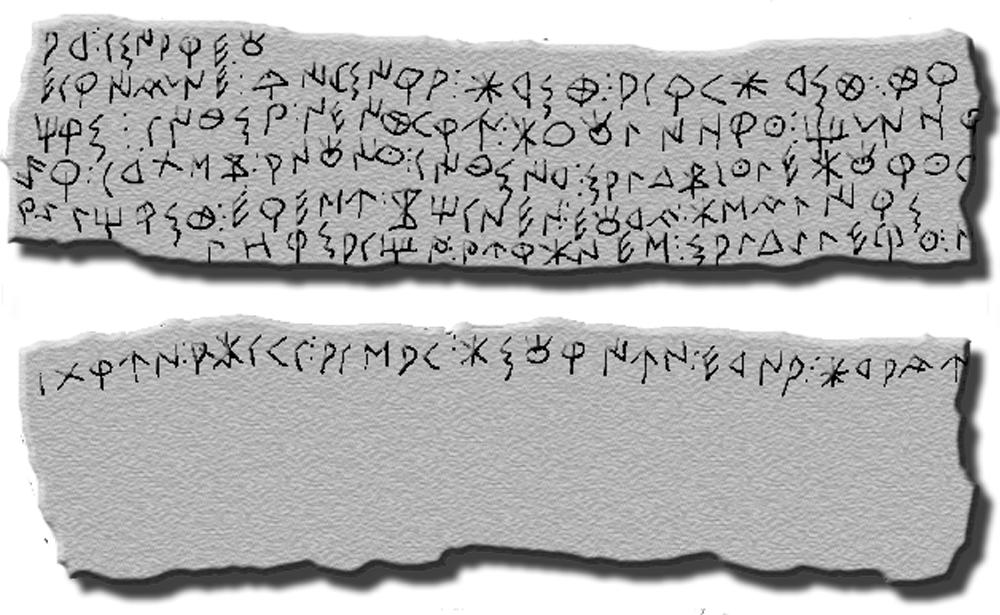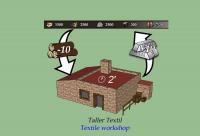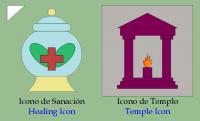-
Posts
13 -
Joined
-
Last visited
Profile Information
-
Gender
Male
-
Location
Madrid
-
Interests
Art, Desing, Antrophology, Videogames ;)
Recent Profile Visitors
Keinmy's Achievements

Discens (2/14)
4
Reputation
-

Iberians Culture / Cultura Íberia
Keinmy replied to Keinmy's topic in Tutorials, references and art help
Mira, yo no estoy aqui para bromas, ni para perder el tiempo. Yo estoy aquí en plan serio. Justificaciones de por que el vascoiberismo no es algo 100% aceptado te pongo las fuentes: La lengua ibérica es considerada habitualmente una lengua aislada. No obstante, tras constatar las diversas afinidades existentes con la lengua vasca y la aquitana, muchos investigadores han propuesto que tales afinidades se justificarían por algún tipo de parentesco, siendo conocida esta teoría como vascoiberismo. Pero también hay muchos otros investigadores que creen que esas afinidades no provienen necesariamente de una relación de parentesco, puesto que las afinidades fonológicas podrían ser debidas a fenómenos de área lingüística entre lenguas que comparten un mismo territorio, mientras que las afinidades de léxico y onomásticas podrían ser debidas al préstamo lingüístico. https://es.wikipedia.org/wiki/Idioma_íbero Y te pongo además el blog de Enrique Cabrejas que es el filolofo del que he hablado http://estudiosibericos.blogspot.com/2014/06/la-sfic-respalda-la-tesis-de-enric.html http://enriquecabrejas.blogspot.com -

Iberians Culture / Cultura Íberia
Keinmy replied to Keinmy's topic in Tutorials, references and art help
59/5000 I do not understand what is happening. I do not know what joke it is. O_O -

Iberians Culture / Cultura Íberia
Keinmy replied to Keinmy's topic in Tutorials, references and art help
Please, I will not discuss this further. I am Spanish, I know what I speak, study culture, study my culture. I learned the history of Euskera in school and in culture debates, not in wikipedia. If you think that the Bascones and the Iberians are the same, then be happy. But it is not true. In 1918 the legislation of orthography of Euskera was not created. It was created a new neutral language taking aspects and parts of all the languages that exist in the Basque region. In fact, the authentic Basque language, which is spoken in the villages, has nothing to do with the new Euskera. That's why it was created, because they could not debate and organize among themselves. -

Iberians Culture / Cultura Íberia
Keinmy replied to Keinmy's topic in Tutorials, references and art help
I want to treat this entry as a small illustrated atlas of the Iberian culture. But I attend to your requests. Famous Iberians: I would choose Hilmice, Indibil, Orison. -Hilmice, was a princess Iberian, she married with Hannibal Barca. She was a peacemaker. It could be a kind of Hero Priest, with ability to provoke peace (as it happens at the beginning of the gameplay), advantages over temples or some type of Carthaginian militia. -Alucio, was a prince celtiberian (Is not iberian but...) The payment to Escipion with a huge treasure, for the rescue of his lover. And I also give an army of 1400 horsemen at the disposal of the Carthaginians. The advantages are evident: creation of riders, abundance of metals ... -Abelox, was a warrior iberian. He was a negotiator with Romans and Carthaginians. ¿Advantages over diplomacy, ease in being allies?-Besadino, he was a senior military officer. He was taken prisoner by Roman. -Bilistages, he was a leader iberian ally of Rome. He had asked for a reinforcement of 3000 men to hold the siege. ¿Advantage of continued appearance of militia for a time? -Budar, he was a warrior iberian, he lost was defeated by the Roman praetor Quinto Minucio Termo. -Culcas, he was a leader of iberians, he rose up in arms against the Roman Republic, leading the forces of 17 cities. -Indibil, he was a leader of iberians. He had quarrels with Rome and Carthage. He wanted the independence of both. Him history is very long, but basically he fight very strong against the invasion of Rome. -Orison, he was a leader. Successor of Istolacio e Indortes, they were defeated by the Carthaginian Amilcar Barca, whose elephants caused terror among the Iberian troops. He being more cunning, he used a herd of brave bulls, with fire on the antlers, to scare the elephants and also burn the enemy camp. Advantage: brave bull unit (it scare horse, elephants and war animals) and provocate burns in building. He got the first defeat to the Carthaginian army. To my knowledge there is no known "wonder" belonging to the Iberians (A buildings I refer to as a palace, because the statue of Lady of Elche itself is a jewel) in the sense of something that has been well preserved. I have to say that finding Cancho Roano as marvel ibera in the gameplay caused me a smile (Cancho Roano belongs to the Tartessic culture). But if I had to put an Iberian wonder, in the game, I would like to put a generic sanctuary (a complex of religious buildings similar to the acropolis of Athens). There are many cases, and apparently the splendor of the cities more than making palaces for men, they did for the gods. When I write about the architecture of Iberians, I will give some examples. For the moment I leave these sketches about the Iberian sanctuary " de la Luz" in Murcia. -

Iberians Culture / Cultura Íberia
Keinmy replied to Keinmy's topic in Tutorials, references and art help
I correct, it makes sense. If you compare a map where Catalan and Valencian (Dialect of Catalan) are spoken with a map of the Levantine Iberian regions, you will see that it corresponds to the zones (And same happens with the Basque area and the current Euskera). I understand you. But the differences that exist between tribes (Iberos, Vascones, Celtas ...) are very marked, mainly because of the climates. Believe that today a Galician and an Andalusian are very different, even in the character. Think at that time! It is like saying that Hellenes and Romans were equal for having architecture, clothes and similar gods. Caution! Catalan is not the Iberian language, just as Euskera is not either. But it makes more sense for Catalan to speak Basque, for the justification I have given that they share exactly the same areas. In fact, Euskera is a language created in the 19th century as a unitary language for all populations of the Basque culture. That is, the Iberians of the game speak a language of a century ago. That is why the Spanish are so shocked by this decision XD. I promise that if I find a serious dictionary of Iberian terms (Currently there is much new age romanticism with the theme that destroys more than fix ¬ ¬) I will go up the terms. PD: There is a very old language, which is not regulated but if registered, and which is probably more related to the ancient Iberian, is Aranés. It is a language that is only spoken in an area of the Pyrenees. Is that it would be very interesting in truth. I'll upload a sample when I can. Don't worry, Im spanish XD. If you need to find information about the text and I'm looking for it ;). My main source of information for ibera culture, among others, is the scientific magazine of archeology "despertar ferro", mainly because it has updated information on the subject. https://www.despertaferro-ediciones.com If you like military history look at it, you will surely like it. I like more the artistic and anthropological part. jeje -

Iberians Culture / Cultura Íberia
Keinmy replied to Keinmy's topic in Tutorials, references and art help
In the second post, I will emphasize the cities, I will write later. // En el segundo post, haré hincapié en las ciudades, lo escribiré más adelante. -

Iberians Culture / Cultura Íberia
Keinmy replied to Keinmy's topic in Tutorials, references and art help
(TRADUCCIÓN EN CASTELLANO) ¡Hola! Me encanta este juego ¡Llevo jugándolo años! Pero sigo sin comprender por qué en el juego la cultura íbera parece la cultura de los pordioseros, a parte de las inexactitudes histórico-artísticas que posee. He de entender que hay un grabe desconocimiento sobre esta cultura y como estudioso en la materia que soy quisiera ofreceros una visión realista sobre ella. En este primer post, quiero hablar un poco de las culturas que había en la península y aprovechar para hacer hincapié en algo que me parece tan desconcertante, como cuando Quentin Tarantino confunde la cultura española con la mexicana y pone a los mejicanos cantando flamenco en sus películas, y es el idioma que se le ha puesto a los íberos en el juego: el vascón o euskera. En la península Iberica (Que no Íbera) tenemos varias culturas que podrían clasificarse en las siguientes macro-culturas: Celtas, que ocuparon el noroeste ampliamente ocupando tambien el interior, estos celtas se podrían dividir en 2: -Los celtas de costa, más plenos (Galaicos y Astures...) y los Celtas de Interior con más particularidades (Cántabros, Vaceos, Célticos y Carpetanos /Que casi podrían formar un grupo propio/) Lusitanos, que también se clasifican como celtas pero poseen una cultura marcadamente diferenciada y vinculada también con los Vettones. Turdetanos/Tartésicos, que ocupan el sur de la península. Hay muchas discusiones para clasificar esta cultura puesto que la zona fue un cúmulo y reunión de culturas. Dejémoslo ahí. Celtíberos, que ocuparon el interior de la península, y como indica su etimología poseen rasgos iberos y celtas. Íberos, que ocuparon la costa mediterranea. Y que pueden clasificarse en dos: Iberos levantinos, localizados en la costa este y vinculados más al mar mediterráneo. Iberos beticos, localizados en la región sur y vinculados más interior concretamente al sistema bético. Vascones, que ocuparon una pequeña región en la costa cantábrica al norte, siendo un pueblo cerrado y aislado. Curiosamente en la actualidad las regiones ocupadas por estos pueblos se corresponden (más o menos) con regiones, las cuales poseen características de etnografía y folclore, e incluso de lenguaje y acento. Celtas: Costa: Galicia, Asturias. || Interior: Cantabria, Castilla y León, Castilla la Mancha. Lusitanos: Portugal || Vettones: Extremadura. Turdetanos/Tartésicos: Andalucía Occidental. Celtíberos: Aragón (Plenamente además) Íberos: Levantinos: Cataluña y Valencia. || Béticos: Murcia y Andalucía Oriental. Vascones: País Vasco, La Rioja y Navarra. (Estos últimos más suavemente) Los íberos hablaban íbero y es cierto que no tenemos un diccionario claro de este idioma pero vasta un vistazo para comprender que la cultura ibera poco tiene que ver con la vascona. De hecho en la zona que ocupan los antiguos vascones se sigue hablando Euskera, un idioma que no tiene absolutamente nada que ver con las lenguas romances emparentadas con el latin, de hecho los estudios apuntan a que está emparentado con el aquitano hablado en el sur de francia y pirineos; Mientras que en la zona que antiguamente ocupaba el pueblo íberio, y por eso he resaltado el texto, se habla un idioma, más un dialecto del mismo, llamado Catalán. Lo cual hace más probable por lógica, que el Catalán esté más vinculado con el Íbero que el Euskera, y por consiguiente el Catalán debería ser el idioma que han de tener en el juego. -
(TRADUCCIÓN EN CASTELLANO EN EL SIGUIENTE POST) Hello! I love this game. I've been playing it for years! But I still do not understand why in the game the Iberian culture seems the culture of the beggars, apart from the historical-artistic inaccuracies that it has. I have to understand that there is a lack of knowledge about this culture and as a scholar in the subject that I am, I would like to offer you a realistic view of it. In this first post, I want to talk a little about the cultures that were in the peninsula and take advantage to remark something that I find so disconcerting, as when Quentin Tarantino confuses Spanish culture with Mexican culture and puts the Mexicans singing flamenco in their films, and it is the language that has been put to the Iberians in the game: the vascon or euskera. In the Iberian Peninsula we have several cultures that could be classified in the following macro-cultures: Celts, who occupied the northwest widely also occupying the interior, these Celts could be divided into 2: The Celtic coast, more ¿fully? (Galaicos and Astures ...) And the Celts of Interior with more particularities (Cantabrians, Vaceans, Celtics and Carpetans / Who could almost form their own group /) Lusitanians, who are also classified as Celts but have a markedly differentiated culture and also linked with the Vettones. Turdetanians / Tartesic, that occupy the south of the peninsula. There are many discussions to classify this culture since the area was a heap and meeting of cultures. Let's leave it there. Celtiberians, who occupied the interior of the peninsula, and as its etymology indicates Iberian and Celtic features. Iberians, who occupied the Mediterranean coast. Can be classified in two: Iberian Levantine, located on the east coast and more linked with the Mediterranean Sea. Iberian Betic, located in the southern region and more linked specifically with the "Sistema Bético" (Some mountains in the southeast). Basques, who occupied a small region on the Cantabrian coast to the north, being a "locked in itself" and isolated town. Curiously at present, the regions occupied by these peoples correspond (more or less) with regions, which have characteristics of ethnography and folklore, and even of language and accent. Celts: Coast: Galicia, Asturias. || Interior: Cantabria, Castilla y León, Castilla la Mancha. Lusitanians: Portugal || Vettones: Extremadura. Turdetanians / Tartesic: Western Andalusia. Celtiberians: Aragón (Fully addition) Iberians: Levantines: Catalonia and Valencia. || Betics: Murcia and Eastern Andalusia. Basques: Basque Country, La Rioja and Navarra. (The latter more gently) The Iberians spoke Iberian and it is true that we do not have a clear dictionary of this language but with a glance to understand that the Iberian culture has little to do with the Basque culture. In fact, in the area occupied by the ancient Basques, Euskera is still spoken, a language that has absolutely nothing to do with Romance languages related to Latin, in fact studies suggest that it is related to the Aquitano spoken in the south of France and the Pyrenees; While in the area that formerly occupied the Iberian people, and that is why I have highlighted the text, a language is spoken, plus a dialect of it, called Catalan. Which makes it more likely by logic, that the Catalan is more linked to the Iberian than the Basque, and therefore the Catalan should be the language they must have in the game. (See a political map of Spain and check it)
-

Presentation and suggestions for general game (Castellano and English)
Keinmy replied to Keinmy's topic in General Discussion
Sorry I forget publish with the translation in English: -RPI4 «Icons» My proposal of the principle is a universal icon temple (Building Mythical, symbolized by the triangle, very common element in religions to represent the sacred, whose interior houses an altar with a fire/light sacred). As to heal, I stress that it is very difficult to see and confusing, it is true that the serpent is a symbol of medicine (from using your poison) but the staff of Asclepius is not so, even confusing up looking like the caduceus of Hermes (god of commerce). The albarelo, container for collecting medicinal plants, is a universal symbol, I have a loose idea of how it could be adding plant leaves and the red cross to a contemporary understanding. It could also be a glass with two entwined snakes, but we are talking about the same, a container. As I said, are suggestions, you who make the game at the end are those who enjoin. About the Iberians: I'll insist that the Iberians never spoke Euskera for several reasons:1 / The evidence found in archaeological sites show that cultural exchange was just beyond what would occur in a single trade.2 / The Basques, who have a mountain-northern culture, historically have always been a closed people in the sense of not leaving your site and have a strong independent culture own.(ie no expansionist or colonizer field, which does not want or intend to influence other peoples). Instead the Iberians, which have a Mediterranean culture, have always had contact with different cultures: Phoenicians, Tartars, Greeks, Egyptians, Romans, Etruscans ... etc. Furthermore of the two cultures arent similar in something.3 / The Basques are Basque, and the Iberians are Iberians. That is, if the Basques were Iberians, not exist Iberian culture, since it would Basque culture.4 / If the Iberians speak Basque, one could have deciphered the Iberians texts from the beginning, and Basques would have the Iberian alphabet in their language.5 / Concerning this and by that I end the argument, an intensive study completed in 2012, got first decrypt the Iberian alphabet, whose discoverer Enrique Cabrejas Iñesta (anthropologist and philologist), rebelled that language and therefore Iberian culture comes from the Greek (the study would say that the Iberians came from an ancient Greek colony that took independence in Iberia) Here I leave a debate on the topic:http://www.celtiberia.net/articulo.asp?id=1584 And a link to the discoverer:http://enriquecabrejas.blogspot.com.es/2013/12/la-lengua-iberica-descifrada.html I would love to participate in the art section and remake the Iberians buildings based on studies and archeology. But only manage Sketchup, however it could team up with someone who could make 3d bender providing illustrations and drawings.Thank for read -

Presentation and suggestions for general game (Castellano and English)
Keinmy replied to Keinmy's topic in General Discussion
RTP6- can work and now in the next alphas we can test "capturing" building monuments and shrines can have a bonus against capturing ( is a suggestion ) RTP4 «Iconos»: Yo lo que propuse al principio es un icono universal de templo (Edificio Místico, simbolizado por el triangulo, elemento muy común en lo que es la religión para representar lo sagrado, cuyo interior alberga un ara con un fuego/luz sagrado). En cuanto al de sanar, recalco que es muy difícil de ver y confuso, cierto es que la serpiente es un símbolo de medicina (por la utilización de su veneno) pero el cayado de Asclepio no lo es tanto, incluso resulta confuso por parecerse al caduceo de Hermes (dios del comercio). El albarelo, recipiente destinado a recoger las plantas medicinales, es un símbolo universal, yo he dado una vaga idea de como podría ser añadiéndole hojas de planta y la cruz roja para un entendimiento contemporáneo. También podría ser una copa con dos serpientes enroscadas, pero estaríamos hablando de lo mismo, un contenedor. Ya digo que son sugerencias, vosotros que hacéis el juego al final sois los que mandáis. Sobre los Iberos: Vuelvo a insistir en que los Iberos nunca hablaron Euskera por varios motivos: 1/ Las pruebas encontradas en yacimientos arqueológicos demuestran que apenas hubo intercambio cultural más allá de lo que se daría en un simple comercio. 2/ Los vascos, que poseen una cultura montañesa-norteña, históricamente siempre han sido un pueblo cerrado en el sentido de no moverse de su sitio y de tener una marcada cultura propia independiente (es decir no tienen ámbito expansionista ni colonizador, con lo cual no quieren ni pretenden influir en otros pueblos). En cambio los Iberos, que poseen una cultura mediterránea, han tenido siempre contacto con diversas culturas: fenicios, tartesos, griegos, egipcios, romanos, etruscos...etc. Además ninguna de las dos culturas se parecen en algo. 3/ Los vascos son vascos, y los Iberos son Iberos. Es decir, si los vascos fueran iberos, no se daria una cultura íbera, puesto que seguiria siendo la cultura vasca. 4/ Si los iberos hablasen euskera, se podria haber descifrado los textos iberos desde un principio, y los vascos tendrian el alfabeto ibero en su lengua. 5/ Referente a esto y con esto quiero zanjar la discusión, un estudio intensivo finalizado en el año 2012, consiguió por primera vez descifrar el alfabeto ibero, cuyo descubridor Enrique Cabrejas Iñesta (antropólogo y filólogo), rebeló que el lenguaje y por lo tanto la cultura íbera proviene del griego (El estudio vendría a decir que los iberos surgieron de una antigua colonia griega que tomó independencia en la península Íbera) Aquí te dejo un debate sobre el tema: http://www.celtiberia.net/articulo.asp?id=1584 Y aquí un enlace sobre el descubridor: http://enriquecabrejas.blogspot.com.es/2013/12/la-lengua-iberica-descifrada.html Me gustaría mucho poder participar en el apartado artístico y rehacer los edificios íberos basándome en los estudios y en la arqueología. Pero solo se manejar el Sketchup, no obstante podría hacer equipo con alguien que supiera hacer 3d en bender proporcionándole ilustraciones y planos. -

Presentation and suggestions for general game (Castellano and English)
Keinmy replied to Keinmy's topic in General Discussion
I instead would propose, taking the Greek case as example, and according to I said about the automatic dedication of the temples: Zeus / Athena / Hera: would the gods base, that is when there is no a god in particular. Zeus for being the king of gods, Athena to be precisely "the goddess of towns or cities that protects' (many cities like Athens and Mycenae, come from the name of the goddess) and Hera for being the queen of the gods.Poseidon: When there is a large fishing fleet or where the temple stands near water.Demeter: When farm work is important, or stands near the fieldsArtemis: when done near a forest or played with setting night.Apolo: When player statistics are above those of the other players (ie this at the time of splendor) or is played with setting day.Ares: when the temple was built in the middle of a battle.Hades: when it gets near a vein of stone or there have been many deaths continued.Herfesto: When is done by forging or a vein of metal.Hestia: when building near the houses.Aphrodite / Dionisio: when excessive birth or peacetime.Obviously one should look rituals, ceremonies and mysteries that had each deity worship and for what purpose were made to make these "favors" and corresponding rewards. Besides adding a shortcut to rotate the type of temple (eg ctrl + click) to suit the user. For monotheistic religions, it is clear that only have one option and in the case of religions without much information as you opt for the chief god (treating it as monotheism).Leveraging what you just said about Basque and Iberians gods, I want to make clear that the Iberians have absolutely nothing to do with the Basques. I do not know where you brought that information but all they had in Basque and Iberian common was a trade route, which barely had cultural exchange. THE IBERIANS NOT SPOKE THE BASQUE. But that is another topic that clearly fails in another post that is atrocious as you have placed the Iberian culture in the game with that mud architecture straight out of central Africa. -----------------------------------------------------------CASTELLANO--------------------------------------Yo más bien propondría tomando el caso griego como ejemplo y según lo que he dicho sobre la dedicación automática del templo: -Zeus/Atenea/Hera: serian los dioses base, es decir cuando no hay un dios en especial. Uno por ser el rey de dioses y otra por ser precisamente «la diosa de las ciudades o la que proteje las ciudades» (muchas ciudades como Atenas o Micenas, vienen del nombre de esta diosa) y Hera por ser la reina de dioses. -Poseidon: cuando hay una importante flota pesquera o cuando se erige el templo cerca del agua. -Demeter: cuando la labor agricola es importante, o se erige cerca de los campos de cultivo. -Artemisa: cuando se hace cerca de algún bosque o se juega con ambientación noche. -Apolo: cuando las estadisticas del jugador estan por encima de las de los otros jugadores (es decir esta en su momento de explendor) o se juega con ambientación de día. -Ares: cuando se esta en medio de una batalla. -Hades: cuando se hace cerca de una veta de piedra o ha habido muchas muertes continuadas. -Herfesto: cuando se hace cerca de la forja o de una veta de metal. -Hestia: cuando se construye cerca de las casas. -Afrodita/Dionisio: cuando hay una excesiva natalidad. Obviamente habría que mirar los rituales, ceremonias y misterios que tenia cada deidad en su culto y con que fin se realizaban para hacer estos "favores" y sus correspondientes recompensas. Además de añadir un atajo para rotar el tipo de templo (por ejemplo ctrl+click) para gusto del usuario. En el caso de religiones monoteístas, esta claro que solo habría una opción y en el caso de religiones sin mucha información pues se optaría por el dios principal (tratándolo como monoteismo). Aprovechando lo que acabas de decir sobre dioses vascos e Iberios, quiero dejar claro que los iberos no tienen absolutamente nada que ver con los vascos. No se de donde habéis sacado esa información pero lo único que tenían en común vascos e iberos era una ruta comercial, de la que escasamente había intercambio cultural. LOS IBEROS NO HABLARON EUSKERA. Pero eso ya es otro tema que dejare claro en otro post por que es atroz como habéis puesto la cultura Ibera en el juego con esa arquitectura de barro que parece sacada de centro África. -

Presentation and suggestions for general game (Castellano and English)
Keinmy replied to Keinmy's topic in General Discussion
Thank you for your feedback. I forgot to add that: in my opinion there are too military buildings and few civilian. Supposedly in the game we create a city ,and a city can not be by building "4 simple buildings". There my importance in the add new buildings: temples, monuments, workshops ... etc. In all games I've played I've finished with loads of food resources and very little metal Also say that these proposed comments are based on my real experience as a player. My answers: REGARDING THE PROPOSED ISSUE (RPI) -RPI2 «Workshop» (Lion.Kanzen, Itms): I am not referring to exchange resources with other cities, if not slow equalization of resources. In all ¿games? I've played and I've finished with loads of food resources and very little metal, and working to "buy / sell" in the market to buy metal at 1 metal x 100 food becomes tedious. Hence the idea of workshops. It is internal movement of resources, no external movement of resources and a passive performance, no active. Create various workshops would be based on the workshops do not alternate the activity, a bread oven is always a bread oven, could not be closed and the next day make pottery. Maybe it could be something like "Guild workers " one building that looks like a various that works as one. -RPI3 «Monuments» (sanderd17, Lion.Kanzen): Rather would say it is difficult to find 9 monuments of every culture, but if any must be haha. So I exposed what that style monuments, not monuments in particular. That is a statue of classic style, not The Doryphoros of Polykleitos. Anyway I can the investigative work, I think it could raise at least 3 works of each stage and culture. -RPI4 «Icons» (sanderd17): I continue to believe that is a great historical mistake, this gesture of prayer just what do Christians and Buddhists (no gaming culture has these religions) and do not believe that all users of the game at whether Christian or Buddhist. According: Why not put a gun or a tank instead of swords to represent the barracks? But of course this is my opinion. -RPI5 «Priests / Healers» (sanderd17): The altars or shrines (not temples) function as a priest who can not move and only the priest could build. Would type something like this (EXAMPLE) The Alliance I meant when playing against AI and was to add one more example of favor. -RPI6 «Temples» (sanderd17, ITMS): A small temples I mean things type the Temple of Athena Nike (51 x 112 x 8mm) not in a great temple as might be the Parthenon (69.5 x 30.9 x 20m). though we could choose to have the first temple to be built is the Great Temple and the following are common temples (ie small, as if they were chapels). On divine helps, of course I mean things "fervor of faith" and not magic, taking the gods or God as "patrón de". ----CASTELLANO----Gracias por vuestros comentarios. Se me ha olvidado añadir que para mi gusto hay demasiados edificios militares y pocos civiles. Supuestamente en el juego se crea una ciudad, y una ciudad no creo que pueda hacerse construyendo «4 edificios» de ahi mi importancia en la aparición de nuevas edificaciones: templos, monumentos, talleres...etc. Decir también que estos comentarios propuestos se basan en mi experiencia como usuario Mis contestaciones: REFERENTE AL TEMA PROPUESTO (RTP) -RTP2 «Talleres» (Lion.Kanzen, Itms): No me estoy refiriendo a intercambiar recursos con otras ciudades, si no a una lenta nivelación de los recursos. En todas las partidas que he jugado he acabado con mogollón de recursos de comida y muy poco de metal, y la labor de compra/venta en el mercado para adquirir metal a 1 de metal x 100 de comida se hace tedioso. De ahí la idea de talleres. Se trata de movimiento interno de recursos no movimiento externo de recursos y de una actuación pasiva, no activa . Lo de crear varios talleres estaría basado en que los talleres no alternan su actividad, es decir un horno de pan es siempre un horno de pan, no podría cerrarse y al día siguiente hacer una alfarería. Quizas podria ser algo en plan «Gremio de trabajadores» un solo edificio con apariencia de varios que funciona como uno solo. -RTP3 «Monumentos» (sanderd17, Lion.Kanzen ): Más bien diria que es dificil encontrar los 9 monumentos de cada cultura, pero haberlos tiene que haber jaja, no estamos hablando de tribus si no de civilizaciones. Por eso expuse lo de monumentos con ese estilo, no monumentos en concreto. Es decir una estatua de estilo clasico no el Doriforo de Policleto. De todas formas no me importaría hacer la labor de investigación, creo que podria reunir al menos 3 obras de cada etapa y cultura. -RTP4 «Iconos» (sanderd17): Sigo opinando que es un gran error historico, ese gesto de oracion solo lo tienen los cristianos y los budistas (ninguna cultura del juego posee esas religiones) y tampoco creo que todos los usuarios del juego a nivel mundial sean cristianos o budistas. Según eso ¿Por que no poner una escopeta o un tanque en lugar de espadas para representar el cuartel? Pero claro esta es mi opinión. -RTP5 «Sacerdotes/Curanderos» (sanderd17): Lo de los altares o templetes (que no templos) funcionarían como un sacerdote que no se puede mover y solo los podria construir el sacerdote. Serian algo tipo asi (http://www.romanorumvita.com/wp-content/uploads/2012/09/mulva_400.jpg) Lo de la alianza me referia a cuando se juega contra IA y fue por añadir un ejemplo más de favor. -RTP6 «Templos» (sanderd17, Itms ): A templos pequeños me refiero a cosas tipo el Templo de Atenea Nike (51 x 112 x 8m) no a un gran templo como podría ser el Partenón (69,5 x 30,9 x 20m) , aunque se podria optar por que el primer templo que se construye sea el Gran Templo y lo siguientes sean templos comunes (es decir pequeños, como si fueran capillas). Sobre las ayudas divinas, claro esta que me refiero a cosas de «fervor de fe» y no a magia, tomando a los dioses o dios como «Patrón de». -
(ESCRITO EN CASTELLANO MÁS ABAJO) Hi, this is my first post. I would first like to thank the whole team who have managed to make this game so great and altruistically. Second notice that my English is not entirely good (and even more so when you have to talk with technical terms) so in part by traslator Google help me and also leave the text in my original language (if there be any misunderstanding). If anyone would like to help translating, great. I start with my suggestions for improving the game, but not before warning that I Studies in design and art, besides being amateur anthropologist, and therefore I have knowledge of what I mean here. start:-1-I think it should be changed the "evolutionary transformation stylist" that happens when you exceed an age in which all buildings change their style a better instantly. This is part seeing very unrealistic makes losing the historical essence. So I propose that every single age you can build in a style without evolves to advance period, for example, a house built on a stage keep this aspect throughout the entire game. -2-One of the things I miss most in the game is the sensation of city because missing buildings, so I suggest the emergence of "building workshops / stores" to help balance and regulate the economy transforming surpluses of a other less resource. These buildings also would have a 'on / off' button to stop or turn this exchange. Example: Suppose there is a textile workshop, this workshop would take resources wood and very slowly transform into metal (in equal measure). When we would stop this transformation would suffice to close the premises. -3-Another fail I find is that sometimes a resource is a bit away from the area of influence and can not built near this resource (or similar situation), so I propose that in every age could build 3 different monuments (9 in total) that would increase the area that in addition give a major historical and city look. Example: playing with the Greek civilization we could build:* in stage I, an Kuros an Hereo, an Agora.* Stage II, the theater of Dionysus, Hercules Farnese and a temple of Artemis in Ephesus.* And in stage III, the Altar of Zeus, the Mausoleum of Halicarnassus and the Colossus of Rhodes.(Add that these are just examples, the ideal would be to build a common example (a theater, a temple, a statue ... etc) and not a particular work)-4-Something I think it should be changed completely serious healing icon (currently a staff with a coiled snake pointing to the right) and the temple icon (represented as two hands together). The first to be confused as just looks and deceives the point; The second being that gesture (the hands clasped in prayer) a gesture at that time was only in Buddhism. Formerly each town had its way of praying, for example in Rome-Greek of that time they prayed to the gods of sky showing palms up and the gods of the earth with palms down (see picture). Thus I propose that the icon of healing is replaced by the image of a pot or albarelo blue (color formerly associated with healing) and the temple by a building consisting of a tympanum, 2 columns and an altar inside. -5- is currently the religion is in the doldrums and most people prefer the bloodthirsty warriors (if not the Spartans and their god of war) but do not forget that ancient religion and priests were an important part of every community. In this game does not exist magic component and truth is that by that time there was preaching as we would understand the Middle Ages, so the clergy has relegated them to the role of healers is not far from what they should do then. However healers game are of little use and considering its high price and that several buildings are carrying out this mission, create healers is all a whim. So concerning this religious theme I propose many things to highlight it and make sense within the game:--a-- Priests possess aura bonus and improvement. Is to say everything around this character, moved by faith or ecstasy, acts more efficiently (moves faster, collect food faster, heal faster ... etc.).--b-- Priests can create altars which have the aura bonus described above.--c-- Priests can perform animal sacrifices for favors such as: reveal the map or get for an enemy who becomes allied or neutral, for example. This in addition to assist and encourage in the game, would give greater meaning to "pens" which become a bit useless as there orchards and wild animals. -6- Finallyand referring to religion, also I miss a greater utility and presence of temples, could make these also had aura bonus (perhaps arranged as small altars-temples), in which improvements could be developed and provide temporary support. In polytheistic cases, these temples could be dedicated to a deity chosen as unfavorable statistics (For exampleif there were few food resources would be a god of agriculture, we were in battle to a god of war, if we need more people to a fertility god etc). Example: Temple of Ceres, goddess of agriculture> Elected to click on build temple for having a lower index of food resources. Gives +10 in collecting food in nearby farms. Develops "Blessing of the seed" with which orchards take less time to create. In addition also develops "Cerealia" Harvest Festival in honor of Ceres that for 5 minutes makes food collection is intensive, and that even after 30 minutes can not be reinstated. It is clear that in different cultures these suggestions would have to adapt. Well these are my suggestions about the game in general. I hope these ideas like and are accepted. Thanks for reading--------------------------------------------------CASTELLANO---------------------------------------------------------------------------- Hola, este es mi primer post. Quisiera primero dar las gracias a todo el equipo que habéis conseguido realizar este juego tan fantástico y de forma altruista. Segundo advertir que mi ingles no es del todo bueno (y más aun cuando se tiene que hablar con tecnicismos) así que en parte me ayudaré por Google traslator y además dejaré el texto en mi lengua original (por si surgiera alguna mala interpretación). Si alguien quisiera ayudarme traduciendo, estupendo. Empiezo con mis sugerencias para la mejora del juego, no sin antes advertir que tengo estudios en diseño y arte, a parte de ser antropólogo aficionado, y que por lo tanto tengo conocimiento de lo que aqui me refiero. Comienzo: -1-Creo que se debería cambiarse la «transformación evolutiva estilista» que ocurre al superarse una época, en la cual todos los edificios cambian su estilo por otro mejor instantáneamente. Esto a parte de verse muy irreal hace perder la esencia histórica. Así pues propongo que en cada época solo se pueda construir en un estilo, sin que evolucione al avanzar de periodo, con lo cual por ejemplo, una casa construida en una etapa mantendrá dicho aspecto durante todo el juego. -2-Una de las cosas que más echo en falta en el juego es la sensación de ciudad puesto que faltan edificios, así pues propongo la aparición de «edificios talleres/tiendas» que ayuden a equilibrar y regular la economía transformando los excedentes de un recurso en otro con menos indice. Estos edificios además contarían con un botón «on/off» para parar o activar dicho intercambio. Ejemplo: Supongamos que hay un taller textil, este taller tomaría recursos de madera y los transformaría de forma muy lenta en metal (en la misma medida). Cuando quisiéramos parar esa transformación bastaría con clausurar el local. -3-Otro fallo que encuentro es que a veces un recurso esta un poco lejos del área de influencia y no se puede construir cerca de dicho recurso (o alguna situacion similar), así pues propongo que en cada época se pudieran construir 3 monumentos diferentes (9 en total) que harían aumentar el área que además darían un mayor aspecto histórico y de ciudad. Ejemplo: jugando con la civilización helena podríamos construir: *en la etapa I, un Kuros, un Hereo, un Agora. *en la etapa II, el teatro de Dionisio, un Hércules de Farnesio y un templo de Artemisa de Éfeso. *Y en la etapa III, el Altar de Zeus, el Mausoleo de Halicarnaso y el Coloso de Rodas. (Añadir que esto son solo ejemplos, lo ideal seria construir un ejemplo común (un teatro, un templo, una estatua...etc) y no una obra concreta) -4-Algo que creo que debería ser cambiado totalmente seria el icono de curación (actualmente es una vara con una serpiente enroscada que apunta a la derecha) y el icono de templo (representado como dos manos juntas). La primera por ser confusa ya que apenas se ve y engaña al apuntar; La segunda por ser ese gesto (el de las manos unidas en oración) un gesto que en aquella época solo se daba en el budismo. Antiguamente cada pueblo tenia su forma de rezar, por ejemplo en la roma-grecia de la epoca se rezaba a los dioses del cielo mostrando las palmas hacia arriba y a los dioses de la tierra con las palmas hacia abajo (ver imagen). Asi pues propongo que el icono de curación sea sustituido por la imagen de un tarro o albarelo de color azul (color antiguamente asociado a la curación) y el de templo por un edificio compuesto por un tímpano, 2 columnas y un ara en su interior. -5-Ya se que actualmente la religión esta de capa caída y la mayoría de la gente prefiere a los sanguinarios guerreros (cuando no a los espartanos y su dios de la guerra) pero no hay que olvidar que antiguamente la religión y los sacerdotes eran una parte importante de toda comunidad. En este juego no existe el componente mágico y cierto es que por aquella época no existía la predicación como la entenderíamos en la edad media, así que a los clérigos se les ha relegado a la funcion de curanderos que no esta muy lejos de lo que deberian hacer por aquel entonces. No obstante los curanderos del juego no sirven de mucho y teniendo en cuenta su alto precio y que varios edificios cumplen ya esa misión, crear curanderos es todo un capricho. Así pues referente a este tema religioso propongo varias cosas para realzarlo y darle sentido dentro del juego: --a--Sacerdotes poseen un aura de bonificación y mejora. Es decir todo lo que este alrededor de este personaje`, movido por la fe o el éxtasis, actúa más eficientemente (se mueve mas rápido, recoge alimentos más rápido, se cura más rápido...etc.). --b--Sacerdotes pueden crear altares los cuales poseen el aura de bonificación anteriormente descrito. --c--Sacerdotes pueden realizar sacrificios de animales para obtener favores como pueden ser revelaciones puntuales o estratégicas en el mapa, o bien conseguir favor de un enemigo que se vuelve aliado o neutral, por ejemplo. Esto además de ayudar y favorecer en el juego, daría mayor sentido a los «corrales» los cuales se vuelven un poco inútiles al existir los huertos y animales salvajes. -6-Por ultimo y referente a la religión, también echo en falta una mayor utilidad y presencia de templos, se podría hacer que estos también tuvieran aura de bonificación (quizás dispuestos como altares-templos pequeños), en los cuales se pudieran desarrollar mejoras y proporcionar ayudas temporales. En casos politeístas, estos templos podrían estar dedicados a una deidad escogida según estadísticas desfavorables (por ejemplo si hubiera escasos recursos de comida seria a un dios de agricultura, si estuviéramos en plena batalla a un dios de la guerra, si necesitáramos mas población a un dios de la fertilidad etc). Ejemplo: Templo de Ceres, diosa de la agricultura > Elegido al pinchar en construir templo por haber un bajo indice de recursos de comida. Otorga +10 en recogida de alimento en granjas cercanas. Desarrolla «Bendición de la semilla» con lo cual las huertas tardan menos en crearse. Además tambien desarrolla «Cerealia» Fiesta de la cosecha en honor a Ceres que durante 5 minutos hace que la recogida de alimentos sea intensiva, que hasta pasados 30 minutos no se puede volver a realizar. Claro está que según cada cultura estas sugerencias se habrían de adaptar. Bueno estas son mis sugerencias con respecto al juego en general. Espero que dichas ideas gusten y sean aceptadas.


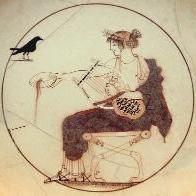

.thumb.jpg.b21ca1d0c15fb56b42c39b25a0a40815.jpg)


